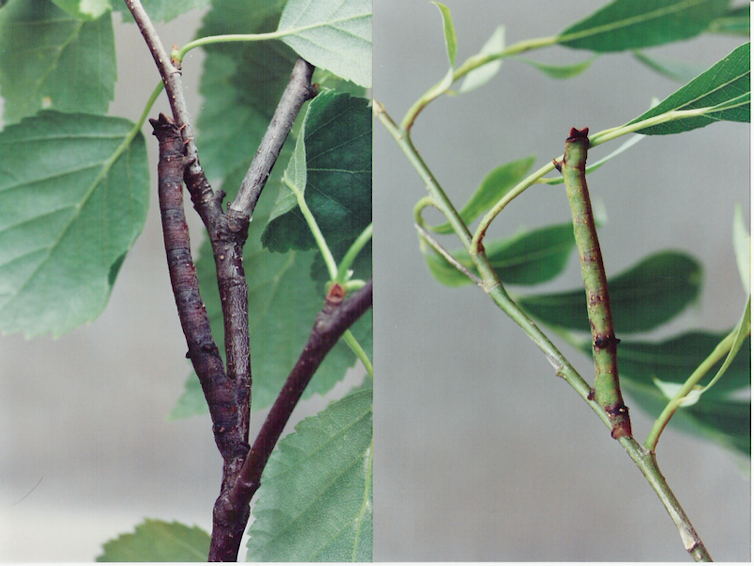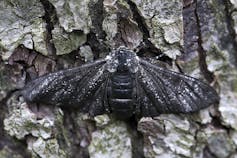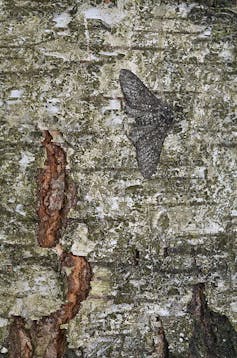How Did The Peppered Moth's Environment Change, And What Caused This Change?
Irresolute wild animals: this article is part of a series looking at how cardinal species such every bit bees, insects and fish respond to ecology change, and what this ways for the rest of the planet.
The earth is constantly changing around united states of america. Nonetheless, we might not realise the importance of a change until nosotros come across its effects on another animal.
The brindled moth will ever hold a special place in the register of evolutionary biology. Its story is a classic example of natural selection, and of how animals tin can act as indicators of environmental alter.
One of two colours
The peppered moth is found throughout Eurasia and North America and can be either white or blackness. When blackness and white morphs breed, their offspring are likewise either blackness or white (rather than grayness), indicating that color is controlled by Mendelian segregation in this species.
Another notable matter is that their survival tends to rely on them tricking their enemies with cover-up; juvenile caterpillars masquerade as twigs, while the adult moths blend into their surroundings. However, when a species relies on a strategy like this, they become vulnerable when the world changes without them.

Adult peppered moths are nigh active at dark and hide (or endeavour to hide) from predators in plain sight during the mean solar day. A typical place for them to hide is on trees, and the more common white morph tends to blend in better with the white bawl birch trees in England than their black counterparts.
Pollution drives natural option
Throughout the industrial revolution, people noticed that white moths became much rarer while black moths became much more common. Bernard Kettlewell, a research boyfriend at the Academy of Oxford, was amongst the first to investigate this puzzling modify in affluence.
He conducted an elegant set of experiments during the 1950s to test whether the soot and pollution from industrialisation made it easier for blackness moths to blend in with their newly muddied surroundings, while white moths were less able to blend in and more vulnerable to predation by birds.

He conducted a series of observations, fieldwork and aviary experiments, and found that his data fit his predictions: blackness moths were condign more abundant because they were existence improve-camouflaged and predated less by birds in soot-covered areas compared to their newly exposed and vulnerable white counterparts.
Understandably, this gear up of experiments became a classic example of Charles Darwin'due south theory of natural selection that was used by teachers throughout the globe.
However, valid disquisitional discussion by fellow scientists of Kettlewell's experimental methods, such equally that moths rarely remainder of tree trunks and unnatural numbers of moths being used in experiments, was exploited by anti-evolutionists who turned molehills into mountains and succeeded in casting doubt on the validity of his piece of work.
Silencing the critics
One of the critics, Michael Majerus from the University of Cambridge, conducted a series of follow up studies in the early 2000s to address his, and others' criticisms of Kettlewell'due south work.
Similar to Kettlewell, he used a combination of natural history observations and a series of field experiments which are amid the most substantial of their kind ever completed.

His experiments were conducted at an unpolluted site, which led to the prediction that white moths should be eaten less than black moths. His results were exactly what were expected: black moths were eaten more often in a make clean wood than the background-matching white moths.
Majerus's experiments addressed his own, and other peoples' criticisms of Kettlewell's work. In doing then, he vindicated Kettlewell'due south original experiments and convincingly demonstrated that predation by birds is selecting colour morph in peppered moths, and that predatory preference depends on the local ecology atmospheric condition.
Unfortunately, while he presented his work at a briefing, he did not live to publish them. The work was published past Cook and co-authors in 2012.
Together, their piece of work comprises perhaps the virtually elegant example of natural option in the world.
We will exist publishing more articles in this series in the coming days.
Source: https://theconversation.com/natural-selection-in-black-and-white-how-industrial-pollution-changed-moths-43061
Posted by: duartetoneady.blogspot.com


0 Response to "How Did The Peppered Moth's Environment Change, And What Caused This Change?"
Post a Comment